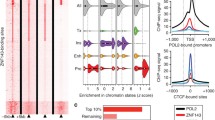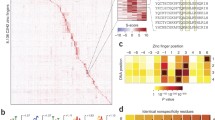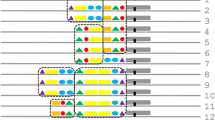Abstract
The zinc transcriptional regulatory element (ZTRE) is a newly reported binding motif for human zinc finger protein ZNF658, which alters gene expression in response to cellular zinc. The ZTRE has two nucleotide components—the palindromic flanking pairs and the bridging “N” bases between these flanks that range in number from 0 to 100. There are 12 pairs of ZTRE flanks (designated A-L). Three thousand five hundred twenty-five genes contain one or more ZTREs − 1000 to + 200 bp from their transcriptional start site (TSS). ZTRE-E is observed at a greater frequency, and ZTRE containing 25 bridging bases are less frequent, within − 200 bp from the TSS. The genes with ZTREs in this range are enriched in processes that may compensate zinc deficiency, while other genes with ZTREs outside this range are enriched in transcriptional activation processes. The division of ZTREs into two groups may imply a dual role of ZNF658, similar to the homologous yeast protein Zap1, via binding to low or high affinity sequences dependent upon cellular zinc. The KLF/Sp1-family binding motif is prevalent within the ZTRE “N” bridging bases, suggesting ZNF658 may compete with Sp1-like transactivators to suppress transcription.



Similar content being viewed by others
References
Najafabadi HS, Mnaimneh S, Schmitges FW, Garton M, Lam KN, Yang A, Albu M, Weirauch MT, Radovani E, Kim PM, Greenblatt J, Frey BJ, Hughes TR (2015) C2H2 zinc finger proteins greatly expand the human regulatory lexicon. Nat Biotechnol 33:555–562. https://doi.org/10.1038/nbt.3128
Klug A (2010) The discovery of zinc fingers and their applications in gene regulation and genome manipulation. Annu Rev Biochem 79:213–231. https://doi.org/10.1146/annurev-biochem-010909-095056
Choi S, Bird AJ (2014) Zinc'ing sensibly: controlling zinc homeostasis at the transcriptional level. Metallomics 6(7):1198–1215. https://doi.org/10.1039/c4mt00064a
Ogo OA, Tyson J, Cockell SJ, Howard A, Valentine RA, Ford D (2015) The zinc finger protein ZNF658 regulates the transcription of genes involved in zinc homeostasis and affects ribosome biogenesis through the zinc transcriptional regulatory element. Mol Cellular Biol 35(6):977–987. https://doi.org/10.1128/mcb.01298-14
Coneyworth LJ, Jackson KA, Tyson J, Bosomworth HJ, van der Hagen E, Hann GM, Ogo OA, Swann DC, Mathers JC, Valentine RA, Ford D (2012) Identification of the human zinc transcriptional regulatory element (ZTRE): a palindromic protein-binding DNA sequence responsible for zinc-induced transcriptional repression. J Biol Chem 287(43):36567–36581. https://doi.org/10.1074/jbc.M112.397000
Huang Y-H, Jankowski A, Cheah KSE, Prabhakar S, Jauch R (2015) SOXE transcription factors form selective dimers on non-compact DNA motifs through multifaceted interactions between dimerization and high-mobility group domains. Sci Rep 5:10398. https://doi.org/10.1038/srep10398
Peirano RI, Wegner M (2000) The glial transcription factor Sox10 binds to DNA both as monomer and dimer with different functional consequences. Nucleic Acids Res 28(16):3047–3055
Lyons TJ, Gasch AP, Gaither LA, Botstein D, Brown PO, Eide DJ (2000) Genome-wide characterization of the Zap1p zinc-responsive regulon in yeast. P Natl A Sci 97(14):7957–7962
Merchant SS, Helmann JD (2012) Elemental economy: microbial strategies for optimizing growth in the face of nutrient limitation. Adv Microb Physiol 60:91–210. https://doi.org/10.1016/b978-0-12-398264-3.00002-4
Wu CY, Bird AJ, Chung LM, Newton MA, Winge DR, Eide DJ (2008) Differential control of Zap1-regulated genes in response to zinc deficiency in Saccharomyces cerevisiae. BMC Genomics 9:370. https://doi.org/10.1186/1471-2164-9-370
Bird AJ, Blankman E, Stillman DJ, Eide DJ, Winge DR (2004) The Zap1 transcriptional activator also acts as a repressor by binding downstream of the TATA box in ZRT2. EMBO J 23(5):1123–1132
Bird AJ, Zhao H, Luo H, Jensen LT, Srinivasan C, Evans-Galea M, Winge DR, Eide DJ (2000) A dual role for zinc fingers in both DNA binding and zinc sensing by the Zap1 transcriptional activator. EMBO J 19(14):3704–3713. https://doi.org/10.1093/emboj/19.14.3704
Frey AG, Eide DJ (2012) Zinc-responsive coactivator recruitment by the yeast Zap1 transcription factor. Microbiologyopen 1(2):105–114. https://doi.org/10.1002/mbo3.8
Frankish A, Diekhans M, Ferreira A-M, Johnson R, Jungreis I, Loveland J, Mudge JM, Sisu C, Wright J, Armstrong J, Barnes I, Berry A, Bignell A, Carbonell Sala S, Chrast J, Cunningham F, Di Domenico T, Donaldson S, Fiddes IT, García Girón C, Gonzalez JM, Grego T, Hardy M, Hourlier T, Hunt T, Izuogu OG, Lagarde J, Martin FJ, Martínez L, Mohanan S, Muir P, Navarro FCP, Parker A, Pei B, Pozo F, Ruffier M, Schmitt BM, Stapleton E, Suner M-M, Sycheva I, Uszczynska-Ratajczak B, Xu J, Yates A, Zerbino D, Zhang Y, Aken B, Choudhary JS, Gerstein M, Guigó R, Hubbard TJP, Kellis M, Paten B, Reymond A, Tress ML, Flicek P (2018) GENCODE reference annotation for the human and mouse genomes. Nucleic Acids Res:gky955-gky955. https://doi.org/10.1093/nar/gky955
R Core Team (2018) R: a language and environment for statistical computing. R Foundation for Statistical Computing, Vienna URL https://www.R-project.org/
Team R (2016) RStudio: Integrated Development for R. RStudio, Inc Boston, MA URL http://www.rstudio.com/
Huber W, Carey VJ, Gentleman R, Anders S, Carlson M, Carvalho BS, Bravo HC, Davis S, Gatto L, Girke T, Gottardo R, Hahne F, Hansen KD, Irizarry RA, Lawrence M, Love MI, MacDonald J, Obenchain V, Oleś AK, Pagès H, Reyes A, Shannon P, Smyth GK, Tenenbaum D, Waldron L, Morgan M (2015) Orchestrating high-throughput genomic analysis with bioconductor. Nat Methods 12:115–121. https://doi.org/10.1038/nmeth.3252
Kearse M, Moir R, Wilson A, Stones-Havas S, Cheung M, Sturrock S, Buxton S, Cooper A, Markowitz S, Duran C, Thierer T, Ashton B, Meintjes P, Drummond A (2012) Geneious basic: an integrated and extendable desktop software platform for the organization and analysis of sequence data. Bioinformatics 28(12):1647–1649. https://doi.org/10.1093/bioinformatics/bts199
Lawrence MHW, Pagès H, Aboyoun P, Carlson M, Gentleman R, Morgan M, Carey V (2013) Software for computing and annotating genomic ranges. PLoS Comput Biol 9:e1003118. https://doi.org/10.1371/journal.pcbi.1003118
Bailey TL, Boden M, Buske FA, Frith M, Grant CE, Clementi L, Ren J, Li WW, Noble WS (2009) MEME suite: tools for motif discovery and searching. Nucleic Acids Res 37(suppl_2):W202–W208. https://doi.org/10.1093/nar/gkp335
Wagih O (2017) ggseqlogo: a versatile R package for drawing sequence logos. Bioinformatics 33(22):3645–3647. https://doi.org/10.1093/bioinformatics/btx469
Altschul SF, Madden TL, Schaffer AA, Zhang J, Zhang Z, Miller W, Lipman DJ (1997) Gapped BLAST and PSI-BLAST: a new generation of protein database search programs. Nucleic Acids Res 25(17):3389–3402
Huang d W, Sherman BT, Lempicki RA (2009) Systematic and integrative analysis of large gene lists using DAVID bioinformatics resources. Nat Protoc 4(1):44–57. https://doi.org/10.1038/nprot.2008.211
Huang d W, Sherman BT, Lempicki RA (2009) Bioinformatics enrichment tools: paths toward the comprehensive functional analysis of large gene lists. Nucleic Acids Res 37(1):1–13. https://doi.org/10.1093/nar/gkn923
Ashburner M, Ball CA, Blake JA, Botstein D, Butler H, Cherry JM, Davis AP, Dolinski K, Dwight SS, Eppig JT, Harris MA, Hill DP, Issel-Tarver L, Kasarskis A, Lewis S, Matese JC, Richardson JE, Ringwald M, Rubin GM, Sherlock G (2000) Gene ontology: tool for the unification of biology. The Gene Ontology Consortium. Nat Genet 25(1):25–29. https://doi.org/10.1038/75556
The Gene Ontology Consortium (2017) Expansion of the gene ontology knowledgebase and resources. Nucleic Acids Res 45(D1):D331–d338. https://doi.org/10.1093/nar/gkw1108
Rost B (1999) Twilight zone of protein sequence alignments. Protein Eng 12(2):85–94
Ito T, Kitamura H, Uwatoko C, Azumano M, Itoh K, Kuwahara J (2010) Interaction of Sp1 zinc finger with transport factor in the nuclear localization of transcription factor Sp1. Biochem Bioph Res Co 403(2):161–166. https://doi.org/10.1016/j.bbrc.2010.10.036
Günther V, Lindert U, Schaffner W (2012) The taste of heavy metals: gene regulation by MTF-1. Biochim Biophys Acta 1823:1416–1425. https://doi.org/10.1016/j.bbamcr.2012.01.005
Wang Y, Weisenhorn E, MacDiarmid CW, Andreini C, Bucci M, Taggart J, Banci L, Russell J, Coon JJ, Eide DJ (2018) The cellular economy of the Saccharomyces cerevisiae zinc proteome. Metallomics 10:1755–1776. https://doi.org/10.1039/C8MT00269J
Maffucci T, Falasca M (2001) Specificity in pleckstrin homology (PH) domain membrane targeting: a role for a phosphoinositide-protein co-operative mechanism. FEBS Lett 506(3):173–179
Chevalier-Larsen E, Holzbaur ELF (2006) Axonal transport and neurodegenerative disease. BBA-Mol Basis Dis 1762(11):1094–1108. https://doi.org/10.1016/j.bbadis.2006.04.002
Evens NP, Buchner P, Williams LE, Hawkesford MJ (2017) The role of ZIP transporters and group F bZIP transcription factors in the Zn-deficiency response of wheat (Triticum aestivum). Plant J 92(2):291–304. https://doi.org/10.1111/tpj.13655
Dolfini D, Zambelli F, Pedrazzoli M, Mantovani R, Pavesi G (2016) A high definition look at the NF-Y regulome reveals genome-wide associations with selected transcription factors. Nucleic Acids Res 44(10):4684–4702. https://doi.org/10.1093/nar/gkw096
To KP, Do M-H, Cho Y-S, Kwon S-Y, Kim SM, Jung C (2018) Zinc inhibits expression of androgen receptor to suppress growth of prostate cancer cells. Int J Mol Sci 19(10). https://doi.org/10.3390/ijms19103062
Passerieux E, Hayot M, Jaussent A, Carnac G, Gouzi F, Pillard F, Picot M-C, Böcker K, Hugon G, Pincemail J, Defraigne JO, Verrips T, Mercier J, Laoudj-Chenivesse D (2015) Effects of vitamin C, vitamin E, zinc gluconate, and selenomethionine supplementation on muscle function and oxidative stress biomarkers in patients with facioscapulohumeral dystrophy: a double-blind randomized controlled clinical trial. Free Radical Bio Med 81:158–169. https://doi.org/10.1016/j.freeradbiomed.2014.09.014
Lomberk G, Urrutia R (2005) The family feud: turning off Sp1 by Sp1-like KLF proteins. Biochem J 392 (Pt 1):1–11. https://doi.org/10.1042/BJ20051234
Funding
This research was partially funded by the University of Georgia Experiment Station Hatch Funds (to AG), the National Institute of Health (R01 GM113242, R01 GM122080), and the National Science Foundation (DMS-1222718, DMS-1438957, DMS-1228288) (to PM).
Author information
Authors and Affiliations
Corresponding author
Additional information
Publisher’s Note
Springer Nature remains neutral with regard to jurisdictional claims in published maps and institutional affiliations.
Rights and permissions
About this article
Cite this article
Francis, M., Cheng, H., Ma, P. et al. Genomic Characterization of the Zinc Transcriptional Regulatory Element Reveals Potential Functional Roles of ZNF658. Biol Trace Elem Res 192, 83–90 (2019). https://doi.org/10.1007/s12011-019-1650-9
Received:
Accepted:
Published:
Issue Date:
DOI: https://doi.org/10.1007/s12011-019-1650-9




